 |
This section helps you understand the various
CCK types
between two curves
and/or surfaces. There are five types of analyses are
available:
- G0: the values are expressed in
millimeters.
When the minimal distance between two vertices is inferior
to 1 micron, the vertices are merged and the surface is
considered as continuous in point.
- G1: the values are expressed in degrees.
When the angle between two surfaces is inferior to 0.5
degree, the surface is considered as continuous in tangency.
- G2:
the values are expressed in percentage.
- G3:the values are expressed in degrees.
- Overlapping: the system detects overlapping curves.
|
|
 |
Connect Checker Types
|
|
|
- Elements:
- Source:
available in all five types of CCK.
- Target:
enabled for CCK Type, “Curve Extremity and
Curve” and “Surface Border and Surface” only.
- Filter Types according to pair of
elements:
-
 Curve-Curve Connection:
Connection analysis when two curves are selected as input
elements. Curve-Curve Connection:
Connection analysis when two curves are selected as input
elements.
-
 Surface-Surface Connection:
Connection analysis when two surfaces are selected as input
elements. Surface-Surface Connection:
Connection analysis when two surfaces are selected as input
elements.
-
 Surface-Curve Connection:
Connection analysis when one surface and one curve are selected
as input elements. Surface-Curve Connection:
Connection analysis when one surface and one curve are selected
as input elements.
- Filter Types according to the
connection mode between two elements:
-
 Boundary:
connection analysis between the boundaries of two
elements will be performed. Boundary:
connection analysis between the boundaries of two
elements will be performed.
-
Surface-Surface:
CCK between surfaces' borders, type corresponding to the old
Surface Connect Checker.
-
Curve-Curve:
CCK between curves' extremities, type corresponding to the old
Curve Connect Checker.
-
 Projection:
connection analysis between the boundary of one element and
projection of that boundary on another element will be
performed. Projection:
connection analysis between the boundary of one element and
projection of that boundary on another element will be
performed.
- Curve-Curve:
CCK between a curve's extremity and its projection on a surface.
- Surface-Surface:
CCK between a surface's border and its projection on a surface.
-
Surface-Curve:
CCK between a curve's extremity and its projection on a curve.
|
 |
Open the
FreeStyle_09.CATPart document. |
|
|
-
Select both curves to be analyzed.
-
Click the Connect Checker icon:

The Connect Checker dialog box is displayed. The Connect
Checker dialog box proposes two layers to switch between the quick
and the full analysis mode:
- Full Analysis
mode
- Quick Analysis
mode
|
 |
Full Analysis mode
|
|
|
The Full Analysis mode
shows information of
all connections found. You can control various options like color scale, comb, envelope
and amplitude. Below given is the
screenshot of the Connect Checker
dialog box in Full Analysis mode. |
|
|
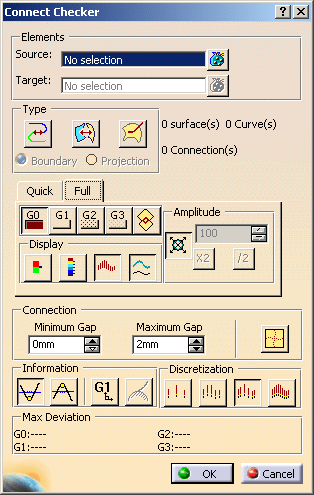 |
 |
- Display:
The full mode
is selected, in this case only one continuity analysis type is
performed, the colors and the range of values are managed in a specific
tool: the color scale. Select any of the two color scale mode:
-
Limited Color Scale: In this mode,
a specific color and a specific threshold are associated to the
continuity type.
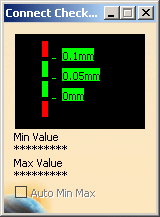
-
Full Color Scale: In
this mode, only one type on continuity is performed,
therefore a color scale allows you to work with
range of values.
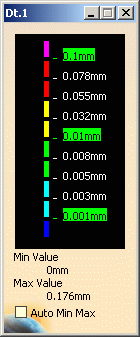
-
The Auto Min Max
button enables to automatically update the minimum and maximum values (and
consequently all values between) each time they are modified.
-
You can right-click on a color in the color
scale to display the contextual menu:

-
Edit: it allows you to modify the
values in the color range to highlight specific areas of the selected
surface. The Color dialog box is displayed allowing you to modify
the color range.
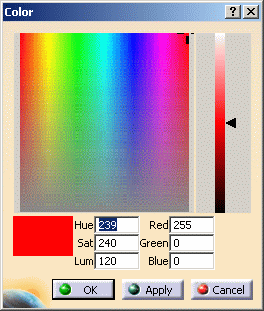
-
Unfreeze: it allows you to
perform a linear interpolation between non defined colors. The unfreezed values are no longer highlighted in green.
-
No Color: it can be used to
simplify the analysis, because it limits the number of displayed colors
in the color scale. In this case, the selected color is hidden, and the
section of the analysis on which that color was applied takes on the
neighboring color.
-
You can also right-click on the value to
display the contextual menu:

-
Edit: it allows you to modify the
edition values. The Value Edition dialog box is displayed: enter a new
value (negative values are allowed) to redefine the color scale, or use
the slider to position the distance value within the allowed range, and
click OK.
The value is then frozen, and displayed in a green rectangle.

-
Use Max/Use Min
: it allows you to evenly
distribute the color/value interpolation between the current
limit values, on the top/bottom values respectively, rather
than keeping it within default values that may not
correspond to the scale of the geometry being analyzed.
Therefore, these limit values are set at a given time, and
when the geometry is modified after setting them, these
limit values are not dynamically updated.
The Use
Max contextual item is only possible if the maximum
value is higher or equal to the medium value. If not, you
first need to unfreeze the medium value. Only the linear
interpolation is allowed, meaning that between two set (or
frozen) colors/values, the distribution is done
progressively and evenly.
|
|
|
- Combo: Allows you to switch
between the four predefined discretization coefficients the icon
layout changed to show current discretization level. You can choose the discretization, that is
the numbers of spikes in the comb (check the Comb option to see
the difference).
The number of spikes corresponds to the number of points used for the
computation:
- Fine: 45 spikes are displayed
- Medium: 30 spikes are displayed
- Coarse: 15 spikes are displayed
- Light: 5 spikes are displayed.
This mode enables to obtain consistent results with the visualization of
sharp edges.
An edge is considered as sharp if its tangency deviation is higher than
0.5 degree. To only detect tangency deviations on sharp edges, specify a
deviation of 0.5 degree minimum.
To visualize sharp edges, make sure the
View > Render Style >
Shading with Edges and Hidden Edges option is checked.
- From the Connect Checker dialog box, you can
choose a number of visualization and computation options:
- the comb: that is the spikes
corresponding to the distance in each point.
- the envelope: that is the curve
connecting all spikes together.
- the Information: that is the minimum
and maximum values displayed in the 3D geometry.
- The minimum and the maximum computed values are displayed in
color scale. Right-click on the color scale and check the following
three options in the contextual menu:
- Edit: Used to define
a color associated to a range of values.
- Unfreeze: Used to
allow a linear interpolation of colors between two frozen colors.
- No color:
Used to hide the analysis result for a range of values.
The 100 (percent) option depicts the standard level of the
scaling factor on which multiplication or division of scaling factor
can be performed.
- Connection
- Maximum Gap:
To get connection
between two input elements, the gap between those two elements
must be less than or equal to Maximum Gap.
- Minimum Gap:
To get connection between two
input elements, the gap between those two elements must be
greater than or equal to Minimum Gap.
- Information: In the case you select several types of
continuity, the Information button is grayed out.
- You can check the Overlapping
button to highlight where, on the common boundary, the two surfaces
overlap. In this case the other analysis types are deactivated.
- You can check the Information
button to display the minimum and maximum values in the 3D geometry, or
uncheck it to hide the values.
- MinInfo:
For surfaces, with the ON/OFF of MinInfo button, the
information for Min values will be displayed.
- MaxInfo:
For surfaces, with the ON/OFF of MaxInfo button, the
information for Max values will be displayed. With change in
descritization, observe the change in Max value display in
dialog box and in graphics area. For curves, observe Max
value in graphics and dialog box is similar for each
continuity type.
- G1 vales within range of 0 to
90 degree: The current
G1 values come from 0 to 180 deg. It may be confusing that the 180 deg value whereas 2 surfaces are tangent, but
superposed for instance. It is the reason why it should be
better to have an option so that the you can choose the
interval of G1 values: 0 - 180 deg or 0 - 90 deg (if G1 > 90
deg, then G1 = 180 - G1). When
you select range 0 – 90 degree, representation of analysis
will be recomputed. The representation of analysis, with “G1
value” button is ON and OFF will be different, if result
values have value more than 90 degree.
- Discretization:The
combo allows you to switch between the four predefined discretization coefficients the icon layout changed to show current
discretization level.
- Maximum Deviation:Deviations
are computed for G0, G1, G2, G3 continuity. You can get the
information about Overlap defect and concavity defect.
|
 |
Quick Analysis mode
|
|
|
The Quick Analysis
mode is the default mode. In
Quick mode you have options to view analysis results above specified
deviation. You have a way to change color of analysis representations.
Below given is the screenshot of the
Connect Checker dialog box in Quick Analysis mode. |
|
|
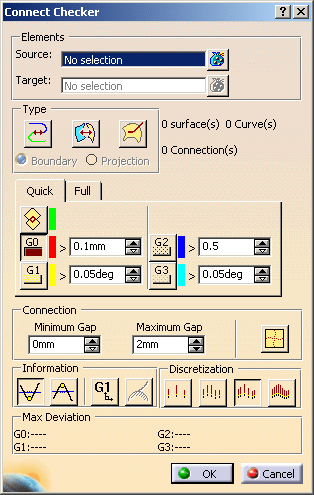 In this case several continuity types can be
performed at the same time, a color and a threshold is associated to
each continuity type. In the quick analysis mode a specific color, a
threshold and a max value (a numerical feedback of the analysis) are
associated to each type.
Some continuity types are combinable, the priority order is
G0, G1, G2, G3 and Overlap. However, the overlap type is not combinable. Each color
is editable.
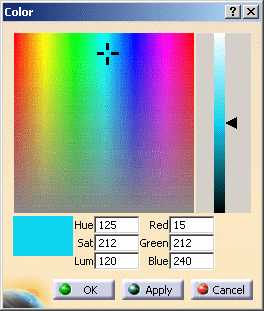 |
 |
Implicit Mode
|
|
|
No type of pair elements is checked, i.e. no filter is set. In this mode
only the following are performed:
- CCK between surfaces' borders,
- CCK between curves' extremities,
- CCK between a curve's extremity and its projection on a surface
An implicit mode depends on selected element types:
- The first selected element is a surface:
- The second selected element is a surface, the connect
checker analysis is the surface connect checker
- The second selected element is a curve, the connect
checker analysis is the surface-curve connect checker
- The first selected element is a 3D curve:
- The second selected element is a 3D curve, the connect
checker analysis is the curve connect checker
- The second selected element is a surface, the connect
checker analysis is the surface-curve connect checker
- The selected elements are surfaces edges, a curve connect
checker analysis is performed
- In case of multi selection, if curves and surfaces are
selected, the surface connect checker is applied on the set of selected
surfaces and the curve connect checker is applied on the set of selected
curves.
|
 |
Explicit Mode
|
|
|
The filters used, i.e. exclusive choice between the types of pair of
elements and choice between the connection modes.
- The explicit mode defined through the dialog box:
- The surface connect checker is set on, only the surfaces
in the selected elements set are taken account to perform the
analysis.
- The curve connect checker is the current mode, only
curves or surfaces edges in the selected elements are taken in to
account.
- The surface curve connect checker is the current mode,
the set of the selected surfaces and the set of the 3D curves are
taken account to perform the analysis.
|
 |
Connection Analysis will be done only if Projection
result of Source Surface border on Target Surface is of type “edge”
only. |
|
|
|


![]()